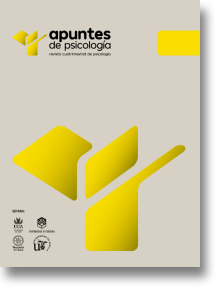Narratives of change for prevention of cannabis use; CANNBIANDO, the stories of Paula and Alex
DOI:
https://doi.org/10.55414/ap.v41i1.921Keywords:
prevention in drugs, cannabis, addiction, narrative, adolescentAbstract
This paper tries to describe the process of elaboration of a narrative tool (storytelling) based on theories about narrative persuasion and the transtheoretical model of Prochaska and DiClemente (1982), with the purpose that it can be used by education, health and social intervention professionals to prevent cannabis use among adolescents between 12 and 18 years of age universally and selectively. The creation process of this audiovisual tool involved the following phases: a) identify psychosocial risk profiles of cannabis use from a review of the scientific literature and interviews with professionals; b) analysis of life stories of adolescent cannabis users; c) creation of two stories based on gender; d) validation of the tool from focus groups; and e) design of an intervention proposal for professionals. In conclusion, we present the process of creating a narrative tool together with an intervention proposal based on scientific, vital and professional evidence, which aims to be useful for professionals dedicated to the field of prevention of cannabis use among adolescents.
References
Bandura A. (2002). Social cognitive theory of mass communication. Media Psychology, 3, 265–299.
Bilandzic, H., y Busselle, R. (2013). Narrative persuasion. In J. P. Dillard, & L. Shen (Eds.), The SAGE handbook of persuasion: Developments in theory and practice (pp. 200-219). Sage. https://www.doi.org/10.4135/9781452218410.n13
Braddock, K., & Dillard, J.P. (2016). Meta-analytic evidence for the persuasive effect of narratives on beliefs, attitudes, intentions, and behaviors. Communication Monographs, 83 (4), 446-467. https://doi.org/10.1080/03637751.2015.1128555
Briñol, P., de la Corte, L., y Becerra, A. (2001). «Qué es» persuasión. Madrid: Biblioteca Nueva.
Brook, J. S., Lee, J. Y., Finch, S. J., Koppel, J., & Brook, D. W. (2011). Psychosocial factors related to cannabis use disorders. Substance Abuse, 32(4), 242–251. https://doi.org/10.1080/08897077.2011.605696
Bruner, J. (1986). Actual minds, possible worlds. Cambridge, MA: Harvard University Press.
Burdzovic Andreas, J., & Pape, H. (2015). Who receives cannabis use offers: A general population study of adolescents. Drug and Alcohol Dependence, 156, 150–156. https://doi.org/10.1016/j.drugalcdep.2015.09.009
Caouette, J. D., & Feldstein Ewing, S. W. (2017). Four Mechanistic Models of Peer Influence on Adolescent Cannabis Use. Current Addiction Reports, 4(2), 90–99. https://doi.org/10.1007/s40429-017-0144-0
Chen, M., Bell, R. A. y Taylor L. D. (2017). Persuasive effects of point of view, protagonist competence, and similarity in a health narrative about type 2 diabetes. Journal of Health Communication, 22, 702-712. doi:10.1080/10810730.2017.1341568
Cho, H., Shen, L., & Wilson, K. (2014). Realism: Dimensions and Roles in Narrative Persuasion. Communication Research, 41(6), 828–851.
DOI: 10.1177/0093650212450585
Christy, K. R. (2018). I, You, or He: Examining the impact of point of view on narrative persuasion. Media Psychology, 21, 700-718. doi:10.1080/15213269.2017.1400443
Conrod, P. J., Pihl, R. O., Stewart, S. H., y Dongier, M. (2000). Validation of a system of classifying female substance abusers on the basis of personality and motivational risk factors for substance abuse. Psychology of addictive behaviors, 14(3), 243.
De Graaf, A., Sanders, J., & Hoeken, H. (2016). Characteristics of narrative interventions and health effects: a review of the content, form, and context of narratives in health-related narrative persuasion research. Review of Communication Research, 4, 88-131. https://doi.org/10.12840/issn.2255-4165.2016.04.01.011
Feldstein, S. W., Filbey, F. M., Loughran, T. A., Chassin, L., & Piquero, A. R. (2015). Which matters most? Demographic, neuropsychological, personality, and situational factors in long-term marijuana and alcohol trajectories for justice-involved male youth. Psychology of Addictive Behaviors, 29(3), 603–612. https://doi.org/10.1037/adb0000076
Fuentes, M., Alarcón, A., García, F., & García, E. (2015). Consumo de alcohol, tabaco, cannabis y otras drogas en la adolescencia: efectos de la familia y peligro del barrio. Anales de Psicología, 31(3), 1000–1007. https://doi.org/http://dx.doi.org/10.6018/analesps.31.3.183491
Gervilla, E., Cajal, B., & Palmer, A. (2011). Quantification of the influence of friends and antisocial behaviour in adolescent consumption of cannabis using the ZINB model and data mining. Addictive Behaviors, 36(4), 368–374. https://doi.org/10.1016/j.addbeh.2010.12.007
Green, M. C. (2006). Narratives and cancer communication. Journal of communication, 56(1), S163-S183.
http://dx.doi.org/10.1111/j.1460-2466.2006.00288.x
Green, M.C., & Brock, T.C. (2000). The role of transportation in the persuasiveness of public narratives. Journal of Personality and Social Psychology, 79(5), 701-721. http://dx.doi.org/10.1037/0022-3514.79.5.701
Grevenstein, D., Nagy, E., & Kroeninger-Jungaberle, H. (2015). Development of Risk Perception and Substance Use of Tobacco, Alcohol and Cannabis Among Adolescents and Emerging Adults: Evidence of Directional Influences. Substance Use & Misuse, 50(3), 376–386. https://doi.org/10.3109/10826084.2014.984847
Gonzálvez, M. T., Espada, J. P., Guillén-Riquelme, A., Secades, R., & Orgilés, M. (2016). Asociación entre rasgos de personalidad y consumo de sustancias en adolescentes españoles. Adicciones, 28(2), 108–115.
https://doi.org/10.20882/adicciones.777
Igartua, J.J. (2011). Mejor convencer entreteniendo: comunicación para la salud y persuasión narrativa. Revista de Comunicación y Salud: RCyS, 1(1), 69-83.
Igartua, J.J., Rodríguez-Contreras, L., Marcos-Ramos, M., González-de-Garay, B., & Frutos, F. J. (2020). Prevención del tabaquismo con mensajes narrativos. Estudio experimental sobre el efecto conjunto de la similitud con el protagonista y la voz narrativa. Adicciones. https://doi.org/10.20882/adicciones.1339
Kim, H. S., Bigman, C. A., Leader, A. E., Lerman, C., & Cappella, J. N. (2012). Narrative health communication and behavior change: The influence of exemplars in the news on intention to quit smoking. Journal of Communication, 62(3), 473-492.
http://dx.doi.org/10.1111/j.1460-2466.2012.01644.x
Marschall, S., Castellanos, N., Vitaro, F., & Séguin, J. R. (2014). Moderators of the association between peer and target adolescent substance use. Addictive Behaviors, 39(1), 48–70. https://doi.org/10.1016/j.addbeh.2013.09.025
McAdams D.P. (2001) The Psychology of Life Stories. Review of General Psychology, 5(2), 100-122.
Medina-Anzano, S., Rueda-Méndez, S. y Herrera-Sánchez, I.M. (2021). CaNNbiando: las historias de Paula y de Álex. Prevención del consumo de cannabis en adolescentes. Salamanca: Comunicación Social.
Moyer-Gusé, E. (2008). Toward a theory of entertainment persuasion: Explaining the persuasive effects of entertainment-education messages. Communication Theory, 18(3), 407-425. http://dx.doi.org/10.1111/j.1468-2885.2008.00328.x
Murray, M. (2000). Levels of Narrative Analysis in Health Psychology. Journal of Health Psychology 5 (3), 337-347. doi: 10.1177/135910530000500305.
Murray, M. (2017). Narrative Social Psychology. En B. Gough (Ed), The Palgrave
Handbook of Critical Social Psychology (pp 185-204). London: Palgrave
Macmillan.
Petraglia, J. (2007). Narrative intervention in behavior and public health. Journal of Health Communication, 6(12), 493-505.
Petraglia, J. (2009). The importance of being authentic: Persuasion, narration, and dialogue in health communication and education. Health communication, 24(2), 176-185.
Prochaska, J. O., & DiClemente, C. C. (1982). Transtheoretical therapy: Toward a more integrative model of change. Psychotherapy: Theory, Research & Practice, 19(3), 276–288.
Prochaska, J. O., Diclemente, C. C., & Norcross, J. C. (1992). In search of how people change: Applications to addictive behaviors. American Psychologist, 47(9), 1102–1114.
Ratcliff, C. L., & Sun, Y. (2020). Overcoming resistance through narratives: Findings from a meta-analytic review. Human Communication Research, 46(4), 412-443.
Rial, A., Burkhart, G., Isorna, M., Barreiro, C., Varela, J., & Golpe, S. (2019). Consumo de cannabis entre adolescentes: patrón de riesgo, implicaciones y posibles variables explicativas. Adicciones, 31(1), 64–77. https://doi.org/10.20882/adicciones.1212
Rueda-Mendez, A.; Medina-Anzano, S.; Leon-Rubio, J. M. (2014). La educación para la salud a través de los medios de comunicación. En R. Martínez Pecino y J.M. Guerra de los Santos. Aspectos psicosociales de la comunicación. Madrid: Pirámide, (pág. 181-191)
Slater, M.D., & Rouner, D. (2002). Entertainment-education and elaboration likelihood: Understanding the processing of narrative persuasion. Communication Theory, 12(2), 173–191. http://dx.doi.org/10.1093/ct/12.2.173
Strobbe. S. & Kurtz, E. (2012) Narratives for Recovery: Personal Stories in the ‘Big Book’ of Alcoholics Anonymous. Journal of Groups in Addiction & Recovery, 7(1), 29-52. doi: 10.1080/1556035X.2012.632320
Walton, M. A., Epstein-Ngo, Q., Carter, P. M., Zimmerman, M. A., Blow, F. C., Buu, A., … Cunningham, R. M. (2017). Marijuana use trajectories among drug-using youth presenting to an urban emergency department: Violence and social influences. Drug and Alcohol Dependence, 173, 117–125.
Downloads
Published
Issue
Section
License
Copyright (c) 2022 APUNTES DE PSICOLOGÍA

This work is licensed under a Creative Commons Attribution-NonCommercial-NoDerivatives 4.0 International License.

















